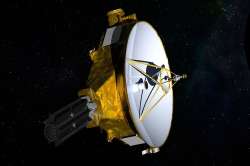NASA's New Horizons spacecraft welcomes 2019 by flying past most distant cosmic object ever explored
According to mission details published by NASA, New Horizons was scheduled to complete the flyby at around 11 am IST Tuesday.

NASA's New Horizons spacecraft kicked off New Year with a historic flyby of Ultima Thule -- the most distant object ever visited by a space probe -- gathering data that may unveil new insights into the formative years of our solar system.
According to mission details published by NASA, New Horizons was scheduled to complete the flyby at around 11 am IST Tuesday.
However, the official confirmation is still awaited, as it will take hours for the spacecraft to communicate with Earth and beam back the first images of the unexplored object.
Ultima Thule -- which means "beyond the known world" -- is located in the Kuiper belt in the outermost regions of the solar system, beyond the orbit of Neptune.
The New Horizons spacecraft flew by Ultima Thule at a distance of 3,500 km. At the time, Ultima Thule was at a distance of almost 6.5 billion kilometres from the Sun, making this the most distant planetary flyby attempted, and the first time that a Solar System object of this type has been seen close-up, NASA said in a statement.
"Ultima is 100 times smaller than Pluto, but its scientific value is incalculable. From everything we know, it was formed 4.5 or 4.6 billion years ago, 4 billion miles from the Sun," said Alan Stern, New Horizons principal investigator from the Southwest Research Institute in the US.
"It's been stored at that enormous distance from the Sun, at a temperature of nearly absolute zero, ever since, so it likely represents the best sample of the ancient solar nebula ever studied. Nothing like it has ever been explored," Stern said in a statement.
"Its geology and composition should teach us a lot about how these building blocks of small planets like Pluto were formed. The New Horizons mission team is excited too, and we can't wait to see what we will find!" he said.
The New Horizons team used the Hubble Space Telescope to search for the next Kuiper Belt object to fly by after Pluto.
Using observations made with Hubble on in 2014, the science team discovered an object that New Horizons could reach with its available fuel.
The object was subsequently designated 2014 MU69, given the minor planet number 485968, and based on public votes, nicknamed "Ultima Thule".
Ultima Thule measures approximately 30 km in diameter, and is irregularly shaped.
In July 2017, Ultima Thule passed in front of a star as seen from Earth , allowing astronomers to determine that its shape is most likely a contact binary (two bodies that are touching) or a close binary system (two objects that are orbiting each other).
The New Horizons is expected to send back the first images of the object to the mission team after 8 pm IST Tuesday.
Based on observations of similar-sized solar system objects, it will almost certainly display impact craters. The lighting environment at its surface is very dim, as it receives only about 0.05 per cent of the light from the Sun that Earth does.
We do know that Ultima Thule has a reddish colour, probably caused by exposure of hydrocarbons to sunlight over billions of years. The flyby will also reveal whether it has any moons, or even a ring system.
Ultima Thule belongs to a class of Kuiper belt objects called the "cold classicals", which have nearly circular orbits with low inclinations to the solar plane, and which have not been perturbed since their formation perhaps 4.6 billion years ago.
Ultima Thule will therefore be the most primitive planetary object yet explored, and will reveal to us what conditions were like in this distant part of the Solar System as it condensed from the solar nebula.